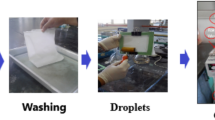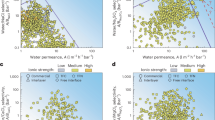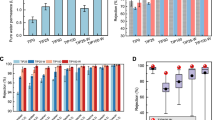Abstract
Reverse osmosis membranes are essential in wastewater treatment, water reuse and desalination, but conventional polyamide reverse osmosis membranes rely on toxic amine monomers such as m-phenylenediamine, posing notable health risks. Here we show that an interfacial catalytic polymerization strategy enables the development of sustainable polyester thin films for membrane desalination. This approach improves reaction kinetics and polymerization control, facilitating the efficient polymerization of nature-derived phenol and alcohol compounds as non-toxic, cost-effective and environmentally friendly alternatives to m-phenylenediamine. The interfacial catalyst enhances both monomer diffusion and polymerization, overcoming the limited reactivity of nature-derived monomers to produce homogeneous, dense polyester thin films. The resulting membranes exhibit excellent desalination performance (NaCl rejection 99.2%; flux 31.7 l m−2 h−1 at 15 bar), comparable to commercial BW30 membranes at both coupon and spiral-wound module scales, demonstrating their potential for practical membrane desalination. This work paves the way for further development of sustainable, nature-derived membrane materials for desalination technologies.
This is a preview of subscription content, access via your institution
Access options
Subscribe to this journal
Receive 12 digital issues and online access to articles
$119.00 per year
only $9.92 per issue
Buy this article
- Purchase on SpringerLink
- Instant access to full article PDF
Prices may be subject to local taxes which are calculated during checkout




Similar content being viewed by others
Data availability
Data generated in this study are provided in the article and Supplementary Information. Source data are provided with this paper.
References
Rosa, L., Chiarelli, D. D., Rulli, M. C., Dell’Angelo, J. & D’Odorico, P. Global agricultural economic water scarcity. Sci. Adv. 6, eaaz6031 (2020).
Flörke, M., Schneider, C. & McDonald, R. I. Water competition between cities and agriculture driven by climate change and urban growth. Nat. Sustain. 1, 51–58 (2018).
McCutcheon, J. R. & Mauter, M. S. Fixing the desalination membrane pipeline. Science 380, 242–244 (2023).
Elimelech, M. & Phillip, W. A. The future of seawater desalination: energy, technology, and the environment. Science 333, 712–717 (2011).
Wang, L. et al. Water transport in reverse osmosis membranes is governed by pore flow, not a solution–diffusion mechanism. Sci. Adv. 9, eadf8488 (2013).
Yao, Y. et al. High performance polyester reverse osmosis desalination membrane with chlorine resistance. Nat. Sustain. 4, 138–146 (2021).
Liang, Y. et al. Polyamide nanofiltration membrane with highly uniform sub-nanometre pores for sub-1 Å precision separation. Nat. Commun. 11, 2015 (2020).
Dai, R. et al. Nanovehicle-assisted monomer shuttling enables highly permeable and selective nanofiltration membranes for water purification. Nat. Water 1, 281–290 (2023).
Geise, G. M. Why polyamide reverse-osmosis membranes work so well. Science 371, 31–32 (2021).
Lim, Y. J., Goh, K., Kurihara, M. & Wang, R. Seawater desalination by reverse osmosis: current development and future challenges in membrane fabrication—a review. J. Membr. Sci. 629, 119292 (2021).
Jones, E., Qadir, M., van Vliet, M. T. H., Smakhtin, V. & Kang, S.-m The state of desalination and brine production: a global outlook. Sci. Total Environ. 657, 1343–1356 (2019).
Lu, X. L. & Elimelech, M. Fabrication of desalination membranes by interfacial polymerization: history, current efforts, and future directions. Chem. Soc. Rev. 50, 6290–6307 (2021).
Park, H. B., Kamcev, J., Robeson, L. M., Elimelech, M. & Freeman, B. D. Maximizing the right stuff: the trade-off between membrane permeability and selectivity. Science 356, eaab0530 (2017).
Poste, A. E., Grung, M. & Wright, R. F. Amines and amine-related compounds in surface waters: a review of sources, concentrations and aquatic toxicity. Sci. Total Environ. 481, 274–279 (2014).
Nikfar, S. & Mozaffari, S. in Encyclopedia of Toxicology (ed. Wexler, P.) 549–553 (Academic, 2024).
Racz, P. I. et al. Application of Caenorhabditis elegans (nematode) and Danio rerio embryo (zebrafish) as model systems to screen for developmental and reproductive toxicity of piperazine compounds. Toxicol. In Vitro 44, 11–16 (2017).
Johnson, W. m-Phenylenediamine and m-phenylenediamine sulfate. Int. J. Toxicol. 36, 42S–43S (2017).
Yan, W., Shi, M., Dong, C., Liu, L. & Gao, C. Applications of tannic acid in membrane technologies: a review. Adv. Colloid Interface Sci. 284, 102267 (2020).
Nguyen-Thi, K.-S. et al. Leveraging tannic acid-ferric iron (TA/Fe3+) complexation in polyamide selective layer for synthesizing robust thin film composite reverse osmosis (TFC-RO) hollow fiber membranes for saline water treatment. Sep. Purif. Technol. 348, 127669 (2024).
Zhao, R. et al. Recycling the high-salinity textile wastewater by quercetin-based nanofiltration membranes with minimal water and energy consumption. Environ. Sci. Technol. 56, 17998–18007 (2022).
Shah, A. A. et al. Preparation of highly permeable nanofiltration membranes with interfacially polymerized biomonomers. J. Membr. Sci. 627, 119209 (2021).
Zheng, J. et al. Sugar-based membranes for nanofiltration. J. Membr. Sci. 619, 118786 (2021).
Ben-Zvi, A., Syed, U. T., Ramon, G. Z. & Nunes, S. Alternative materials for interfacial polymerization: recent approaches for greener membranes. Green Chem. 26, 6237–6260 (2024).
Abdellah, M. H. et al. A catechin/cellulose composite membrane for organic solvent nanofiltration. J. Membr. Sci. 567, 139–145 (2018).
Abdellah, M. H. et al. Effective interfacially polymerized polyester solvent resistant nanofiltration membrane from bioderived materials. Adv. Sustain. Syst. 2, 1800043 (2018).
Pérez-Manríquez, L., Neelakanda, P. & Peinemann, K.-V. Morin-based nanofiltration membranes for organic solvent separation processes. J. Membr. Sci. 554, 1–5 (2018).
Bai, Y. X. et al. Microstructure optimization of bioderived polyester nanofilms for antibiotic desalination via nanofiltration. Sci. Adv. 9, eadg6134 (2023).
Zhang, Y. et al. Composite nanofiltration membranes prepared by interfacial polymerization with natural material tannic acid and trimesoyl chloride. J. Membr. Sci. 429, 235–242 (2013).
Villalobos, L. F., Huang, T. F. & Peinemann, K. V. Cyclodextrin films with fast solvent transport and shape-selective permeability. Adv. Mater. 29, 1606641 (2017).
Liu, J. T., Hua, D., Zhang, Y., Japip, S. & Chung, T. S. Precise molecular sieving architectures with Janus pathways for both polar and nonpolar molecules. Adv. Mater. 30, 1705933 (2018).
Xue, J. et al. Chlorine-resistant polyester thin film composite nanofiltration membranes prepared with β-cyclodextrin. J. Membr. Sci. 584, 282–289 (2019).
Xue, J. et al. High-flux nanofiltration membranes prepared with β-cyclodextrin and graphene quantum dots. J. Membr. Sci. 612, 118465 (2020).
Li, J. et al. Thin-film composite polyester nanofiltration membrane with high flux and efficient dye/salts separation fabricated from precise molecular sieving structure of β-cyclodextrin. Sep. Purif. Technol. 276, 119352 (2021).
Jin, P. et al. Erythritol-based polyester loose nanofiltration membrane with fast water transport for efficient dye/salt separation. Chem. Eng. J. 406, 126796 (2021).
Ding, J., Wu, H. & Wu, P. Development of nanofiltration membranes using mussel-inspired sulfonated dopamine for interfacial polymerization. J. Membr. Sci. 598, 117658 (2020).
Xu, R. et al. Preparation and performance of a charge-mosaic nanofiltration membrane with novel salt concentration sensitivity for the separation of salts and dyes. J. Membr. Sci. 595, 117472 (2020).
Zhan, S. et al. Green lignin-based polyester nanofiltration membranes with ethanol and chlorine resistance. J. Appl. Polym. Sci. 139, 51427 (2022).
Zheng, J. et al. Separation of textile wastewater using a highly permeable resveratrol-based loose nanofiltration membrane with excellent anti-fouling performance. Chem. Eng. J. 434, 134705 (2022).
Jensen, W. B. The Lewis acid–base definitions: a status report. Chem. Rev. 78, 1–22 (1978).
Gu, J.-E. et al. Molecular layer-by-layer assembled thin-film composite membranes for water desalination. Adv. Mater. 25, 4778–4782 (2013).
Jiang, Z., Karan, S. & Livingston, A. G. Water transport through ultrathin polyamide nanofilms used for reverse osmosis. Adv. Mater. 30, 1705973 (2018).
Liu, C. et al. Interfacial polymerization at the alkane/ionic liquid interface. Angew. Chem. Int. Ed. 60, 14636–14643 (2021).
Pinheiro, M. et al. Characterization and comparison of pore landscapes in crystalline porous materials. J. Mol. Graphics Model. 44, 208–219 (2013).
Willems, T. F., Rycroft, C. H., Kazi, M., Meza, J. C. & Haranczyk, M. Algorithms and tools for high-throughput geometry-based analysis of crystalline porous materials. Microporous Mesoporous Mater. 149, 134–141 (2011).
Ongari, D. et al. Accurate characterization of the pore volume in microporous crystalline materials. Langmuir 33, 14529–14538 (2017).
Hafner, J. Ab-initiosimulations of materials using VASP: density-functional theory and beyond. J. Comput. Chem. 29, 2044–2078 (2008).
Kresse, G. & Furthmüller, J. Efficient iterative schemes for ab initio total-energy calculations using a plane-wave basis set. Phys. Rev. B 54, 11169–11186 (1996).
Perdew, J. P., Burke, K. & Ernzerhof, M. Generalized gradient approximation made simple. Phys. Rev. Lett. 77, 3865 (1996).
Acknowledgements
This work was financially supported by the National Natural Science Foundation of China (21988102 to J.J. and U23A20116 to W.F.) and the Key Development Project of Jiangsu Province (BE2022056 to J.J.).
Author information
Authors and Affiliations
Contributions
Y.Z., J.J. and L.J. designed the experiments. Y.L. and W.F. performed all the experiments and the theoretical analysis. Z.Y. and Y.W. contributed materials and analysis tools. Y.L., W.F., Y.Z. and J.J. contributed to writing the manuscript.
Corresponding authors
Ethics declarations
Competing interests
The authors declare no competing interests.
Peer review
Peer review information
Nature Water thanks Huacheng Zhang and the other, anonymous, reviewer(s) for their contribution to the peer review of this work.
Additional information
Publisher’s note Springer Nature remains neutral with regard to jurisdictional claims in published maps and institutional affiliations.
Supplementary information
Supplementary Information
Supplementary text, including Figs. 1–37, Tables 1–9 and references.
Source data
Source Data Fig. 1
Source files of pore size distributions from polyester networks obtained via molecular dynamics simulation.
Source Data Fig. 2
Source files for the investigation of the ICP mechanism.
Source Data Fig. 3
Source files detailing the performance of desalination and the antifouling properties of RO membranes.
Source Data Fig. 4
Source files regarding the performance of pilot-scale membranes and modules.
Rights and permissions
Springer Nature or its licensor (e.g. a society or other partner) holds exclusive rights to this article under a publishing agreement with the author(s) or other rightsholder(s); author self-archiving of the accepted manuscript version of this article is solely governed by the terms of such publishing agreement and applicable law.
About this article
Cite this article
Liu, Y., Fang, W., Yue, Z. et al. Sustainable polyester thin films for membrane desalination developed through interfacial catalytic polymerization. Nat Water 3, 430–438 (2025). https://doi.org/10.1038/s44221-025-00419-6
Received:
Accepted:
Published:
Issue date:
DOI: https://doi.org/10.1038/s44221-025-00419-6



